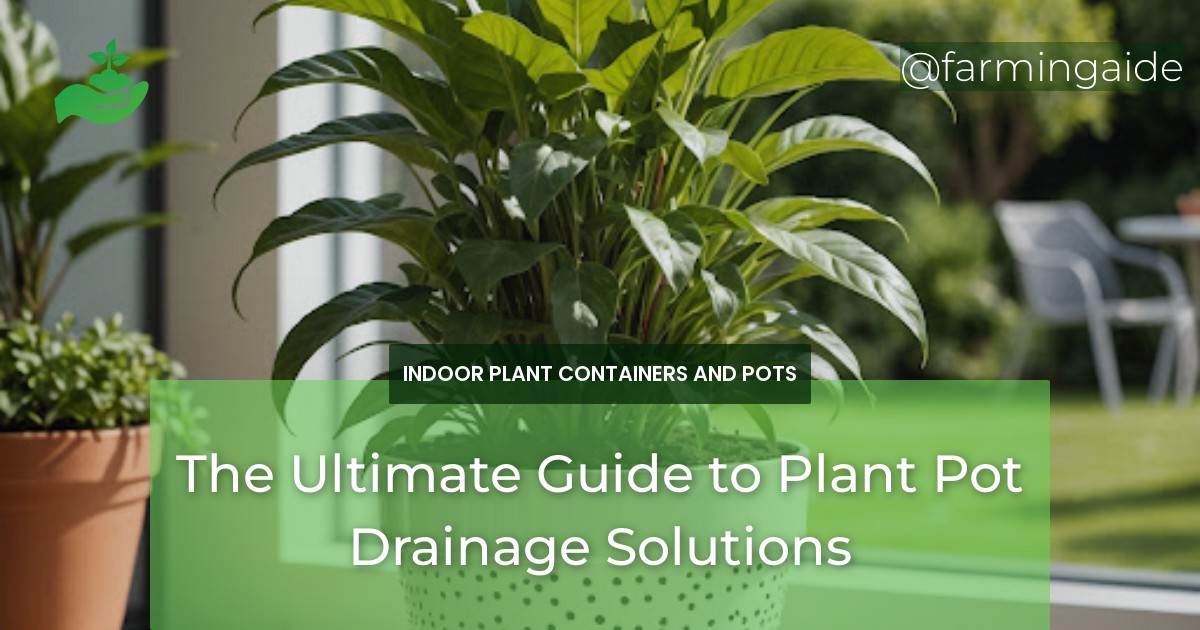As a plant enthusiast, you understand the importance of providing your plants with the right conditions to thrive. One crucial aspect of plant care that’s often overlooked is drainage. Without proper drainage, your plants can suffer from waterlogged soil, root rot, and a host of other problems. In this comprehensive guide, we’ll delve into the world of plant pot drainage solutions, exploring the importance of drainage, different types of solutions, DIY options, and maintenance tips to ensure your plants receive the care they deserve.
Key Takeaways
- Proper drainage is essential for maintaining healthy plants and preventing waterlogged soil.
- There are various types of drainage solutions available, including traditional drainage holes, saucer systems, pebble trays, and wick systems.
- DIY drainage solutions can be effective and budget-friendly.
- Choosing the right drainage solution depends on the type of plant, pot size, and watering habits.
- Regular inspections and cleaning are crucial for maintaining effective drainage.
Understanding the Importance of Drainage in Plant Care
Drainage plays a vital role in maintaining healthy plants. When water drains properly, it prevents waterlogged soil, which can lead to root rot, nutrient deficiencies, and pest problems. Moreover, good drainage ensures that plants receive the right amount of water, reducing the risk of overwatering.
Inadequate drainage can cause a range of problems, including:
The Role of Drainage in Plant Health
Drainage is essential for maintaining healthy roots, stems, and leaves. Plants need oxygen, water, and nutrients to thrive, and drainage ensures that these essential elements are delivered efficiently. Proper drainage also helps to prevent fungal diseases, which thrive in waterlogged conditions.
Common Problems Caused by Poor Drainage
Poor drainage can lead to a range of problems, including:
- Waterlogged soil, which can cause root rot and plant death.
- Nutrient deficiencies due to waterlogged soil.
- Pest problems, such as fungus gnats and spider mites, which thrive in moist environments.
- Reduced plant growth and development.
Types of Drainage Solutions for Plant Pots
There are several types of drainage solutions available, each with its own advantages and disadvantages. Let’s explore some of the most popular options:
ALSO READ
Traditional Drainage Holes
Traditional drainage holes are the most common type of drainage solution. These holes are usually located at the bottom of the pot and allow excess water to drain out. While effective, traditional drainage holes can be prone to clogging and may not provide adequate drainage for plants that require high drainage.
Saucer Systems and Water Reservoirs
Saucer systems and water reservoirs are designed to collect excess water, allowing plants to absorb water as needed. These systems are ideal for plants that prefer moist soil, such as ferns and peace lilies.
ALSO READ
Pebble and Gravel Trays
Pebble and gravel trays provide an additional layer of drainage, preventing water from accumulating in the pot. These trays are particularly useful for plants that prefer well-draining soil, such as cacti and succulents.
Wick Systems for Self-Watering
Wick systems use a wicking material, such as cotton or polyester, to draw water from a reservoir to the plant roots. These systems are ideal for plants that require consistent moisture, such as African violets and begonias.
DIY Drainage Solutions for Plant Pots
While commercial drainage solutions are available, you can also create your own DIY drainage solutions using common materials. Here are a few ideas:
Creating Drainage Holes in Existing Pots
Use a drill or a sharp object to create holes in the bottom of your pot. Make sure the holes are large enough to allow excess water to drain out.
Homemade Drainage Layers
Use materials like perlite, vermiculite, or small rocks to create a drainage layer at the bottom of your pot. This will help to prevent water from accumulating and improve drainage.
Repurposing Materials for Better Drainage
Think outside the box and repurpose materials like broken pottery, pebbles, or even old sponges to create a DIY drainage solution.
Choosing the Right Drainage Solution for Your Plants
Choosing the right drainage solution depends on several factors, including the type of plant, pot size, and watering habits. Here are some tips to consider:
Factors to Consider When Selecting a Drainage System
Before selecting a drainage solution, consider the following factors:
- Type of plant: Different plants have different drainage requirements. For example, cacti and succulents prefer well-draining soil, while ferns and peace lilies prefer moist soil.
- Pot size: Larger pots require more drainage than smaller pots.
- Watering habits: If you tend to overwater, you may need a more robust drainage solution.
Matching Drainage Solutions to Plant Types
Here are some general guidelines for matching drainage solutions to plant types:
| Plant Type | Drainage Solution |
|---|---|
| Cacti and Succulents | Pebble and gravel trays |
| Ferns and Peace Lilies | Saucer systems and water reservoirs |
| African Violets and Begonias | Wick systems for self-watering |
Maintenance Tips for Effective Drainage
Regular maintenance is essential for ensuring that your drainage solution remains effective. Here are some tips:
Regular Inspections and Cleaning
Regularly inspect your drainage system to ensure it’s functioning properly. Clean out any debris or sediment that may be clogging the system.
Adjusting Watering Habits
Adjust your watering habits to ensure you’re not overwatering your plants. Check the soil regularly to determine if it’s dry, moist, or waterlogged.
Conclusion: Ensuring Healthy Plants with Proper Drainage
In conclusion, proper drainage is essential for maintaining healthy plants. By understanding the importance of drainage, selecting the right drainage solution, and maintaining your system, you can ensure that your plants receive the care they deserve. Remember, a well-draining pot is a happy pot!


